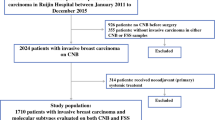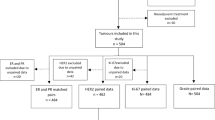Abstract
The concordance of hormone receptors (HR) status identified by core needle biopsy (CNB) compared with excisional biopsy (EB) has been widely reported, but results were extremely variable and underpowered. To derive a more precise estimation of assessment accuracy of CNB for HR in breast cancer, we conducted a meta-analysis of all eligible studies comparing concordance or disconcordance between CNB and EB for HR status. Eligible articles were identified by search of databases including PubMed, Web of Science, EMBASE, and Chinese Biomedical Literature database for the period up to November 2011, and the reference lists of identified studies, relevant reviews, meta-analyses, and abstracts from recent conference proceedings were reviewed as a augmented searching. Finally, a total of 21 articles involving 2,450 patients for estrogen receptor (ER) and 2,448 patients for progesterone receptor (PR) were included and analyzed in this analysis. Study quality was assessed using the Quality Assessment of Diagnostic Accuracy Studies checklist. The overall aggrement between CNB and EB were 92.8 % for ER (κ = 0.78) and 85.2 % for PR (κ = 0.66), indicating a good agreement in PR and a better result in ER. The pooled sensitivity and specificity were 97.3 % (95 % CI 96.0–98.2) and 82.0 % (95 % CI 68.2–90.6) for ER, and the corresponding values for PR were 92.3 % (95 % CI 88.2–95.1) and 76.5 % (95 % CI 64.6–85.3), respectively. The pooled positive likelihood ratios was 5.39 % (95 % CI 2.92–9.97) and the negative likelihood ratios was 0.03 % (95 % CI 0.02–0.05) for ER, the corresponding values for PR were 3.93 % (95 % CI 2.53–6.11) and 0.10 % (95 % CI 0.07–0.16), respectively. In summary, although a good agreement was observed between CNB and EB for both ER and PR, we still suggest that negative HR testing results should be interpreted with caution or repeated on EB.






Similar content being viewed by others
References
Rakha EA, Ellis IO (2007) An overview of assessment of prognostic and predictive factors in breast cancer needle core biopsy specimens. J Clin Pathol 60:1300–1306
Verkooijen HM, Peeters PH, Buskens E, Koot VC, Borel Rinkes IH, Mali WP, van Vroonhoven TJ (2000) Diagnostic accuracy of large-core needle biopsy for nonpalpable breast disease: a meta-analysis. Br J Cancer 82:1017–1021
Goldhirsch A, Wood WC, Gelber RD, Coates AS, Thürlimann B, Senn HJ (2003) Meeting highlights: updated international expert consensus on the primary therapy of early breast cancer. J Clin Oncol 21:3357–3365
Bilous M (2010) Breast core needle biopsy: issues and controversies. Mod Pathol 23:S36–S45
Gown AM (2008) Current issues in ER and HER2 testing by IHC in breast cancer. Mod Pathol 21:S8–S15
Apple S, Pucci R, Lowe AC, Shintaku I, Shapourifar-Tehrani S, Moatamed N (2011) The effect of delay in fixation, different fixatives, and duration of fixation in estrogen and progesterone receptor results in breast carcinoma. Am J Clin Pathol 135:592–598
Lorgis V, Algros MP, Villanueva C, Chaigneau L, Thierry-Vuillemin A, Nguyen T, Demarchi M, Bazan F, Sautiere JL, Maisonnette-Lescot Y, Ringenbach F, Bontemps P, Pivot X (2011) Discordance in early breast cancer for tumour grade, estrogen receptor, progesteron receptors and human epidermal receptor-2 status between core needle biopsy and surgical excisional primary tumour. Breast 20:284–287
Uy GB, Laudico AV, Carnate JM Jr, Lim FG, Fernandez AM, Rivera RR, Mapua CA, Love RR (2010) Breast cancer hormone receptor assay results of core needle biopsy and modified radical mastectomy specimens from the same patients. Clin Breast Cancer 10:154–159
Tamaki K, Sasano H, Ishida T, Miyashita M, Takeda M, Amari M, Tamaki N, Ohuchi N (2010) Comparison of core needle biopsy (CNB) and surgical specimens for accurate preoperative evaluation of ER, PgR and HER2 status of breast cancer patients. Cancer Sci 101:2074–2079
Zagouri F, Sergentanis TN, Nonni A, Papadimitriou CA, Michalopoulos NV, Giannakopoulou G, Bletsa G, Patsouris E, Zografos GC (2010) Comparison of molecular markers expression in vacuum-assisted biopsies and surgical specimens of human breast carcinomas. Pathol Res Pract 206:30–33
Arnedos M, Nerurkar A, Osin P, A’Hern R, Smith IE, Dowsett M (2009) Discordance between core needle biopsy (CNB) and excisional biopsy (EB) for estrogen receptor (ER), progesterone receptor (PgR) and HER2 status in early breast cancer (EBC). Ann Oncol 20:1948–1952
Park SY, Kim KS, Lee TG, Park SS, Kim SM, Han W, Noh DY, Kim SW (2009) The accuracy of preoperative core biopsy in determining histologic grade, hormone receptors, and human epidermal growth factor receptor 2 status in invasive breast cancer. Am J Surg 197:266–269
Hanley KZ, Birdsong GG, Cohen C, Siddiqui MT (2009) Immunohistochemical detection of estrogen receptor, progesterone receptor, and human epidermal growth factor receptor 2 expression in breast carcinomas: comparison on cell block, needle-core, and tissue block preparations. Cancer 117:279–288
Abdsaleh S, Wärnberg F, Azavedo E, Lindgren PG, Amini RM (2008) Comparison of core needle biopsy and surgical specimens in malignant breast lesions regarding histological features and hormone receptor expression. Histopathology 52:773–775
Usami S, Moriya T, Amari M, Suzuki A, Ishida T, Sasano H, Ohuchi N (2007) Reliability of prognostic factors in breast carcinoma determined by core needle biopsy. Jpn J Clin Oncol 37:250–255
Wood B, Junckerstorff R, Sterrett G, Frost F, Harvey J, Robbins P (2007) A comparison of immunohistochemical staining for oestrogen receptor, progesterone receptor and HER-2 in breast core biopsies and subsequent excisions. Pathology 39:391–395
Burge CN, Chang HR, Apple SK (2006) Do the histologic features and results of breast cancer biomarker studies differ between core biopsy and surgical excision specimens? Breast 15:167–172
Cahill RA, Walsh D, Landers RJ, Watson RG (2006) Preoperative profiling of symptomatic breast cancer by diagnostic core biopsy. Ann Surg Oncol 13:45–51
Usami S, Moriya T, Kasajima A, Suzuki A, Ishida T, Sasano H, Ohuchi N (2005) Pathological aspects of core needle biopsy for non-palpable breast lesions. Breast Cancer 12:272–278
Badoual C, Maruani A, Ghorra C, Lebas P, Avigdor S, Michenet P (2005) Pathological prognostic factors of invasive breast carcinoma in ultrasound-guided large core biopsies—correlation with subsequent surgical excisions. Breast 14:22–27
Mann GB, Fahey VD, Feleppa F, Buchanan MR (2005) Reliance on hormone receptor assays of surgical specimens may compromise outcome in patients with breast cancer. J Clin Oncol 23:5148–5154
Al Sarakbi W, Salhab M, Thomas V, Mokbel K (2005) Is preoperative core biopsy accurate in determining the hormone receptor status in women with invasive breast cancer? Int Semin Surg Oncol 2:15
Taucher S, Rudas M, Gnant M, Thomanek K, Dubsky P, Roka S, Bachleitner T, Kandioler D, Wenzel C, Steger G, Mittlböck M, Jakesz R (2003) Sequential steroid hormone receptor measurements in primary breast cancer with and without intervening primary chemotherapy. Endocr Relat Cancer 10:91–98
Götzinger P, Gebhard B, Gnant M, Rudas M, Reiner A, Jakesz R (1998) Value of punch biopsy in diagnosis of palpable breast tumors. A prospective analysis of 150 patients. Chirurg 69:1068–1071
Zidan A, Christie Brown JS, Peston D, Shousha S (1997) Oestrogen and progesterone receptor assessment in core biopsy specimens of breast carcinoma. J Clin Pathol 50:27–29
Di Loreto C, Puglisi F, Rimondi G, Zuiani C, Anania G, Della Mea V, Beltrami CA (1996) Large core biopsy for diagnostic and prognostic evaluation of invasive breast carcinomas. Eur J Cancer 32A:1693–1700
Railo M, Nordling S, Krogerus L, Sioris T, von Smitten K (1996) Preoperative assessment of proliferative activity and hormonal receptor status in carcinoma of the breast: a comparison of needle aspiration and needle-core biopsies to the surgical specimen. Diagn Cytopathol 15:205–210
Whiting P, Rutjes AW, Reitsma JB, Bossuyt PM, Kleijnen J (2003) The development of QUADAS: a tool for the quality assessment of studies of diagnostic accuracy included in systematic reviews. BMC Med Res Methodol 3:25
Whiting P, Weswood ME, Rutjes AW, Reitsma JB, Bossuyt PM, Kleijnen J (2006) Evaluation of QUADAS, a tool for the quality assessment of diagnostic accuracy studies. BMC Med Res Methodol 6:9
Reitsma JB, Rutjes AWS, Whiting P, Vlassov VV, Leeflang MMG, Deeks JJ (2009) Assessing methodological quality, Chap. 9. In: Deek JJ, Bossuyt PM, Gatsonis C (eds) Cochrane handbook for systematic review of diagnostic test accuracy, Version 1.0.0. The Cochrane Collaboration. http://srdta.cochrane.org/en/authors.html
Whiting PF, Rutjes AW, Westwood ME, Mallett S, Deeks JJ, Reitsma JB, Leeflang MM, Sterne JA, Bossuyt PM, QUADAS-2 Group (2011) QUADAS-2: a revised tool for the quality assessment of diagnostic accuracy studies. Ann Intern Med 155:529–536
Higgins JP, Thompson SG, Deeks JJ, Altman DG (2003) Measuring inconsistency in meta-analyses. BMJ 327:557–560
Leeflang MM, Deeks JJ, Gatsonis C, Bossuyt PM, Cochrane Diagnostic Test Accuracy Working Group (2008) Systematic reviews of diagnostic test accuracy. Ann Intern Med 149:889–897
Gatsonis C, Paliwal P (2006) Meta-analysis of diagnostic and screening test accuracy evaluations: methodologic primer. AJR Am J Roentgenol 187:271–281
Reitsma JB, Glas AS, Rutjes AW, Scholten RJ, Bossuyt PM, Zwinderman AH (2005) Bivariate analysis of sensitivity and specificity produces informative summary measures in diagnostic reviews. J Clin Epidemiol 58:982–990
Altman DG, Bland JM (2003) Interaction revisited: the difference between two estimates. BMJ 326:219
Lijmer JG, Bossuyt PM, Heisterkamp SH (2002) Exploring sources of heterogeneity in systematic reviews of diagnostic tests. Stat Med 21:1525–1537
Tobias A (1999) Assessing the influence of a single study in the meta-analysis estimate. Stat Tech Bull 8:15–17
Deeks JJ, Macaskill P, Irwig L (2005) The performance of tests of publication bias and other sample size effects in systematic reviews of diagnostic test accuracy was assessed. J Clin Epidemiol 58:882–893
Zamora J, Abraira V, Muriel A, Khan K, Coomarasamy A (2006) Meta-DiSc: a software for meta-analysis of test accuracy data. BMC Med Res Methodol 6:31
Jemal A, Bray F, Center MM, Ferlay J, Ward E, Forman D (2011) Global cancer statistics. CA Cancer J Clin 61:69–90
Fisher B, Costantino J, Redmond C, Poisson R, Bowman D, Couture J, Dimitrov NV, Wolmark N, Wickerham DL, Fisher ER et al (1989) A randomized clinical trial evaluating tamoxifen in the treatment of patients with node-negative breast cancer who have estrogen-receptor-positive tumors. N Engl J Med 320:479–484
Harris L, Fritsche H, Mennel R, Norton L, Ravdin P, Taube S, Somerfield MR, Hayes DF, Bast RC Jr (2007) American society of clinical oncology 2007 update of recommendations for the use of tumor markers in breast cancer. J Clin Oncol 25:5287–5312
Agarwal G, Pradeep PV, Aggarwal V, Yip CH, Cheung PS (2007) Spectrum of breast cancer in Asian women. World J Surg 31:1031–1040
Lowe AC, Moatamed N, Pucci R, Shintaku IP, Shapourifar-Tehrani S, Shackley B, Apple SK (2010) Estrogen receptor (ER) and progesterone receptor (PR) immunohistochemistry (IHC) results in breast carcinoma using varying fixation times in different fixatives. Mod Pathol 23:60A
van de Ven S, Smit VT, Dekker TJ, Nortier JW, Kroep JR (2011) Discordances in ER, PR and HER2 receptors after neoadjuvant chemotherapy in breast cancer. Cancer Treat Rev 37:422–430
Acknowledgments
We are grateful to Dr. KuSang Kim from Department of Surgery, Seoul National University Bundang Hospital, Seoul, Korea for providing data from their study [12].
Conflict of interest
None.
Author information
Authors and Affiliations
Corresponding author
Additional information
Shichao Li and Xinhua Yang contributed equally to this article and should be considered as co-first authors.
Rights and permissions
About this article
Cite this article
Li, S., Yang, X., Zhang, Y. et al. Assessment accuracy of core needle biopsy for hormone receptors in breast cancer: a meta-analysis. Breast Cancer Res Treat 135, 325–334 (2012). https://doi.org/10.1007/s10549-012-2063-z
Received:
Accepted:
Published:
Issue Date:
DOI: https://doi.org/10.1007/s10549-012-2063-z




